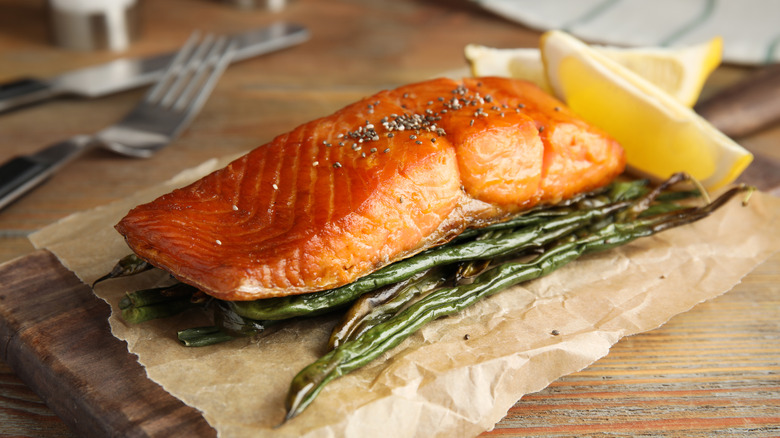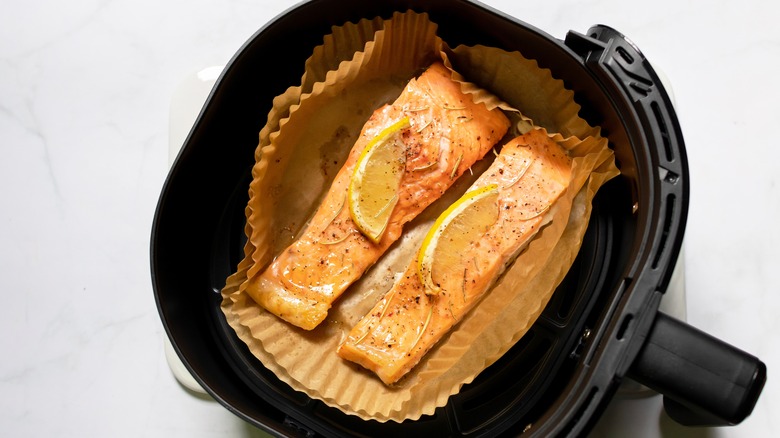Does Salmon Need To Be Flipped While Cooking In The Air Fryer?
Born out of the need for convenience, the versatile air fryer has made virtually everyone a seasoned chef at home. With just the press of a few buttons, you can transform an uncooked piece of chicken or salmon into a fully realized meal without having to keep an eye on the appliance. But, this innovation comes with more questions for at-home chefs to struggle over. Namely, do the same rules of cooking apply? When cooking on a skillet, it is common practice to flip your food to ensure that it cooks evenly.
In the case of salmon, it is more finicky than most. The delicate fish is at its best when it's tender and moist, and it can easily be overcooked. Cooking salmon in an air fryer may be all the rage on TikTok, but is it just as easy in practice? If anything, cooking in the air fryer makes cooking salmon simpler. As opposed to other methods, flipping the fish halfway through is not a large concern. Essentially a miniature version of the convection oven, an air fryer circulates hot air so rapidly that it cooks evenly on all sides. The science behind what makes salmon flaky and delicious is what makes it unnecessary to flip during the cooking process.
Get the best results from your air fryer salmon
Before the salmon is exposed to any heat, it must be treated correctly. Preparing the fish will mean the difference between a perfectly cooked salmon and your worst nightmare. Though a small step, drying the fish before cooking will make a big difference and keep the skin from sticking to the appliance. Setting it in the fridge will also keep the salmon from drying out.
The next step will differ from person to person. Cooking your salmon to completion will depend on your preferred level of done-ness. Fish has the benefit of being enjoyable raw, smoked, or well done, depending on your preferences. Generally, many experts recommend bumping your air fryer to 400 degrees Fahrenheit and only cooking it for about seven or eight minutes. These time increments can differ depending on your specific appliance and the thickness of the cut, but it will be enough to cook through the skin.
Cooking salmon with the skin down is instrumental to keeping the tender texture intact. The layer of fat between the skin and the fish helps retain the moisture of the protein. It insulates the salmon from the extreme heat and overcooking. Rendering this fat in the heat also allows the fish to crisp on the surface while keeping the fish moist on the inside. Cooking with the skin facing up will not produce the same effect.
Other tips for air frying salmon
Just because salmon doesn't need to be flipped in the air fryer doesn't mean it shouldn't, right? This perspective may be a tempting one, especially if you like a crispy exterior on all sides of your fish. Air frying may cook salmon all the way through, but some at-home chefs prefer the crispiness that comes with pan-frying and flipping. Never fear. There are ways to mimic this reaction without plunging your hand into a scalding hot basket.
Instead, do yourself a favor and glaze the top of your salmon with some olive oil. This, in addition to the seasonings, will ensure that the flesh on top will crisp up as the fat renders on the bottom. The inside of the fish will remain moist while still retaining a textured and flaky exterior. Additionally, don't fall into the danger of skimping on aromatics. Even though you're not pan-searing the fish, aromatics are still an integral way of incorporating more flavor into your air-fried salmon. Ingredients such as garlic and ginger will improve the flavor profile and give this dish an edge. Lemon juice is also a classic salmon addition that you shouldn't fear. For a fully balanced dish, fat and acid are necessary components. Lemon juice will add the tangy zip that will make this meal complete.


